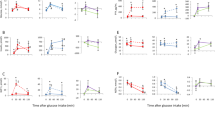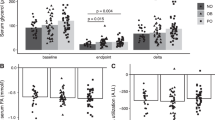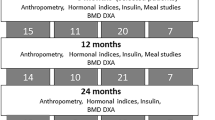Abstract
Background:
Although adjustable gastric banding is increasingly proposed for massively obese patients, little is known about the modifications of resting metabolic rate and substrate oxidation or about metabolic determinants of weight loss following this type of bariatric surgery.
Objectives:
To evaluate the relationships between excess weight loss, resting metabolic rate (RMR) and substrate oxidation, and to identify metabolic predictive factors of weight loss after adjustable gastric banding.
Subjects:
Seventy-three obese nondiabetic women aged 39.1±10.4 years (18.4–64.8).
Design:
Resting metabolic rate and substrate oxidation (indirect calorimetry), body composition (bio-impedance), lipid profile and insulin sensitivity indexes were assessed before and after (13.3±6.0 months, range 6.0–31.1) adjustable gastric banding. Patients were classified according to postsurgery time: group A (6–12 months, n=39); group B (12–18 months, n=21); group C (>18 months, n=13). Metabolic parameters associated with the percentage of excess weight lost (EWL) 1 year after surgery were analyzed in univariate and multivariate regressions.
Results:
Mean weight loss was 26.2±11.4 kg. Mean fat mass loss was 17.3±8.1 kg. All biological parameters associated with excess weight improved after surgery. Excess weight lost at 1 year was 45.9±17.1% in group A, 47.4±17.1% in group B and 51.4±18.5% in group C (P=NS). Resting metabolic rate/fat-free mass (FFM) slightly decreased (28.9±3.26 vs 30.3±2.8, P<0.00001) and RMR/body weight slightly increased (18.5±2.8 vs 17.3±1.9, P<0.00001) after surgery. Respiratory quotient (0.81±0.06 vs 0.82±0.05) and FFM-adjusted lipid oxidation (1.10±0.41 vs 1.05±0.33 mg/min/kg FFM) were not significantly modified after surgery. In multiple linear regression analysis, difference in RMR/body weight, difference in energy sparing, baseline BMI and postsurgery time, were significantly and independently correlated with EWL (total R2=72.5%).
Conclusions:
Adjustable gastric banding promotes gradual but sustained weight loss and is associated with long-term conservation of lipid oxidation and energy expenditure. The individual variability in energy sparing mechanisms predicts weight loss during the first year after surgery.
This is a preview of subscription content, access via your institution
Access options
Subscribe to this journal
Receive 12 print issues and online access
$259.00 per year
only $21.58 per issue
Buy this article
- Purchase on Springer Link
- Instant access to full article PDF
Prices may be subject to local taxes which are calculated during checkout


Similar content being viewed by others
References
Belachew M, Belva PH, Desaive C . Long-term results of laparoscopic adjustable gastric banding for the treatment of morbid obesity. Obes Surg 2002; 12: 564–568.
O'Brien PE, Brown WA, Smith A, McMurrick PJ, Stephens M . Prospective study of a laparoscopically placed, adjustable gastric band in the treatment of morbid obesity. Br J Surg 1999; 86: 113–118.
Weiner R, Blanco-Engert R, Weiner S, Matkowitz R, Schaefer L, Pomhoff I . Outcome after laparoscopic adjustable gastric banding - 8 years experience. Obes Surg 2003; 13: 427–434.
Martikainen T, Pirinen E, Alhava E, Poikolainen E, Paakkonen M, Uusitupa M et al. Long-term results, late complications and quality of life in a series of adjustable gastric banding. Obes Surg 2004; 14: 648–654.
Froidevaux F, Schutz Y, Christin L, Jequier E . Energy expenditure in obese women before and during weight loss, after refeeding, and in the weight-relapse period. Am J Clin Nutr 1993; 57: 35–42.
Valtuena S, Blanch S, Barenys M, Sola R, Salas-Salvado J . Changes in body composition and resting energy expenditure after rapid weight loss: is there an energy-metabolism adaptation in obese patients? Int J Obes Relat Metab Disord 1995; 19: 119–125.
Bobbioni-Harsch E, Morel P, Huber O, Assimacopoulos-Jeannet F, Chassot G, Lehmann T et al. Energy economy hampers body weight loss after gastric bypass. J Clin Endocrinol Metab 2000; 85: 4695–4700.
Buscemi S, Caimi G, Verga S . Resting metabolic rate and postabsorptive substrate oxidation in morbidly obese subjects before and after massive weight loss. Int J Obes Relat Metab Disord 1996; 20: 41–46.
van Gemert WG, Westerterp KR, van Acker BA, Wagenmakers AJ, Halliday D, Greve JM et al. Energy, substrate and protein metabolism in morbid obesity before, during and after massive weight loss. Int J Obes Relat Metab Disord 2000; 24: 711–718.
Dixon JB, O'Brien PE . Selecting the optimal patient for LAP-BAND placement. The American Journal of Surgery 2002; 184: S17–S20.
Busetto L, Perini P, Giantin V, Valente P, Segato G, Belluco C et al. Relationship between energy expenditure and visceral fat accumulation in obese women submitted to adjustable silicone gastric banding (ASGB). Int J Obes Relat Metab Disord 1995; 19: 227–233.
Black AE, Coward WA, Cole TJ, Prentice AM . Human energy expenditure in affluent societies: an analysis of 574 doubly-labelled water measurements. Eur J Clin Nutr 1996; 50: 72–92.
Ferrannini E . The theoretical bases of indirect calorimetry: a review. Metabolism 1988; 37: 287–301.
Matthews DR, Hosker JP, Rudenski AS, Naylor BA, Treacher DF, Turner RC . Homeostasis model assessment: insulin resistance and beta-cell function from fasting plasma glucose and insulin concentrations in man. Diabetologia 1985; 28: 412–419.
Katz A, Nambi SS, Mather K, Baron AD, Follmann DA, Sullivan G et al. Quantitative insulin sensitivity check index: a simple, accurate method for assessing insulin sensitivity in humans. J Clin Endocrinol Metab 2000; 85: 2402–2410.
Naslund E, Freedman J, Lagergren J, Stockeld D, Granstrom L . Three-year results of laparoscopic vertical banded gastroplasty. Obes Surg 1999; 9: 369–373.
Parikh MS, Shen R, Weiner M, Siegel N, Ren CJ . Laparoscopic bariatric surgery in super-obese patients (BMI>50) is safe and effective: a review of 322 patients. Obes Surg 2005; 15: 858–863.
Doucet E, St Pierre S, Alméras N, Mauriège P, Richard D, Tremblay A . Changes in energy expenditure and substrate oxidation resulting from weight loss in obese men and women: is there an important contribution of leptin? J Clin Endocrinol Metab 2000; 85: 1550–1556.
Larson DE, Ferraro RT, Robertson DS, Ravussin E . Energy metabolism in weight-stable postobese individuals. Am J Clin Nutr 1995; 62: 735–739.
Schutz Y, Tremblay A, Weinsier RL, Nelson KM . Role of fat oxidation in the long-term stabilization of body weight in obese women. Am J Clin Nutr 1992; 55: 670–674.
Filozof CM, Murua C, Sanchez MP, Brailovsky C, Perman M, Gonzalez CD et al. Low plasma leptin concentration and low rates of fat oxidation in weight-stable post-obese subjects. Obes Res 2000; 8: 205–210.
Young VR, Marchini JS . Mechanisms and nutritional significance of metabolic responses to altered intakes of proteins and amino acids, with reference to nutritional adaptation in humans. Am J Clin Nutr 1990; 51: 270–289.
Jéquier E . Carbohydrates as a source of energy. Am J Clin Nutr 1994; 59: 682S–685S.
van Dielen FM, Soeters PB, de Brauw LM, Greve JW . Laparoscopic adjustable gastric banding versus open vertical banded gastroplasty: a prospective rendomized trial. Obes Surg 2005; 15: 1292–1298.
Bobbioni-Harsch E, Huber O, Morel P, Chassot G, Lehmann T, Volery M et al. Factors influencing energy intake and body weight loss after gastric bypass. Eur J Clin Nutr 2002; 56: 551–556.
Das SK, Roberts SB, McCrory MA, Hsu LK, Shikora SA, Kehayias JJ et al. Long-term changes in energy expenditure and body composition after massive weight loss induced by gastric bypass. Am J Clin Nutr 2003; 78: 22–30.
Camerini G, Adami GF, Marinari GM, Campostano A, Ravera G, Scopinaro N . Failure of preoperative resting energy expenditure in predicting weight loss after gastroplasty. Obes Res 2001; 9: 589–591.
Camastra S, Bonora E, Del Prato S, Rett K, Weck M, Ferrannini E . Effect of obesity and insulin resistance on resting and glucose-induced thermogenesis in man. EGIR (European Group for the Study of Insulin Resistance). Int J Obes Relat Metab Disord 1999; 23: 1307–1313.
Heshka S, Yang MU, Wang J, Burt P, Pi-Sunyer FX . Weight loss and change in resting metabolic rate. Am J Clin Nutr 1990; 52: 981–986.
Giusti V, Suter M, Heraief E, Gaillard RC, Burckhardt P . Effects of laparoscopic gastric banding on body composition, metabolic profile and nutritional status of obese women: 12-months follow-up. Obes Surg 2004; 14: 239–245.
Author information
Authors and Affiliations
Corresponding author
Rights and permissions
About this article
Cite this article
Galtier, F., Farret, A., Verdier, R. et al. Resting energy expenditure and fuel metabolism following laparoscopic adjustable gastric banding in severely obese women: relationships with excess weight lost. Int J Obes 30, 1104–1110 (2006). https://doi.org/10.1038/sj.ijo.0803247
Received:
Revised:
Accepted:
Published:
Issue Date:
DOI: https://doi.org/10.1038/sj.ijo.0803247
Keywords
This article is cited by
-
Revisiting Resting Metabolic Rate: What is the Relation to Weight Fluctuations?
Current Obesity Reports (2023)
-
Dysmetabolic adipose tissue in obesity: morphological and functional characteristics of adipose stem cells and mature adipocytes in healthy and unhealthy obese subjects
Journal of Endocrinological Investigation (2021)
-
Bariatric Surgery in Adults with Obesity: the Impact on Performance, Metabolism, and Health Indices
Obesity Surgery (2021)
-
Changes in Energy Expenditure of Patients with Obesity Following Bariatric Surgery: a Systematic Review of Prospective Studies and Meta-analysis
Obesity Surgery (2019)
-
Relative Energy Expenditure Decreases during the First Year after Bariatric Surgery: A Systematic Review and Meta-Analysis
Obesity Surgery (2019)



